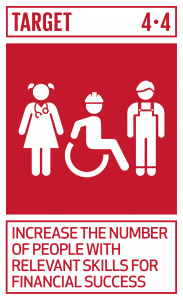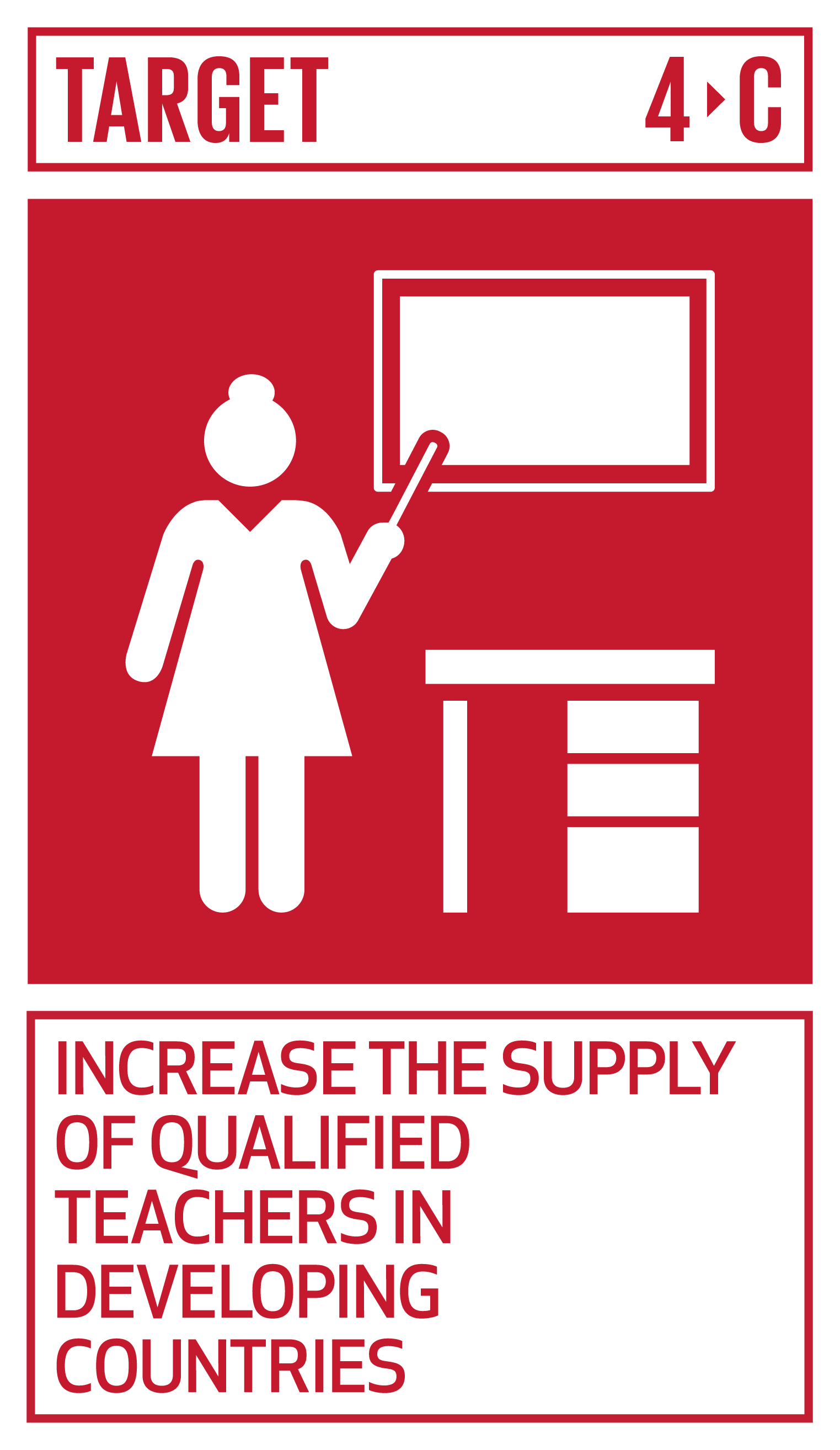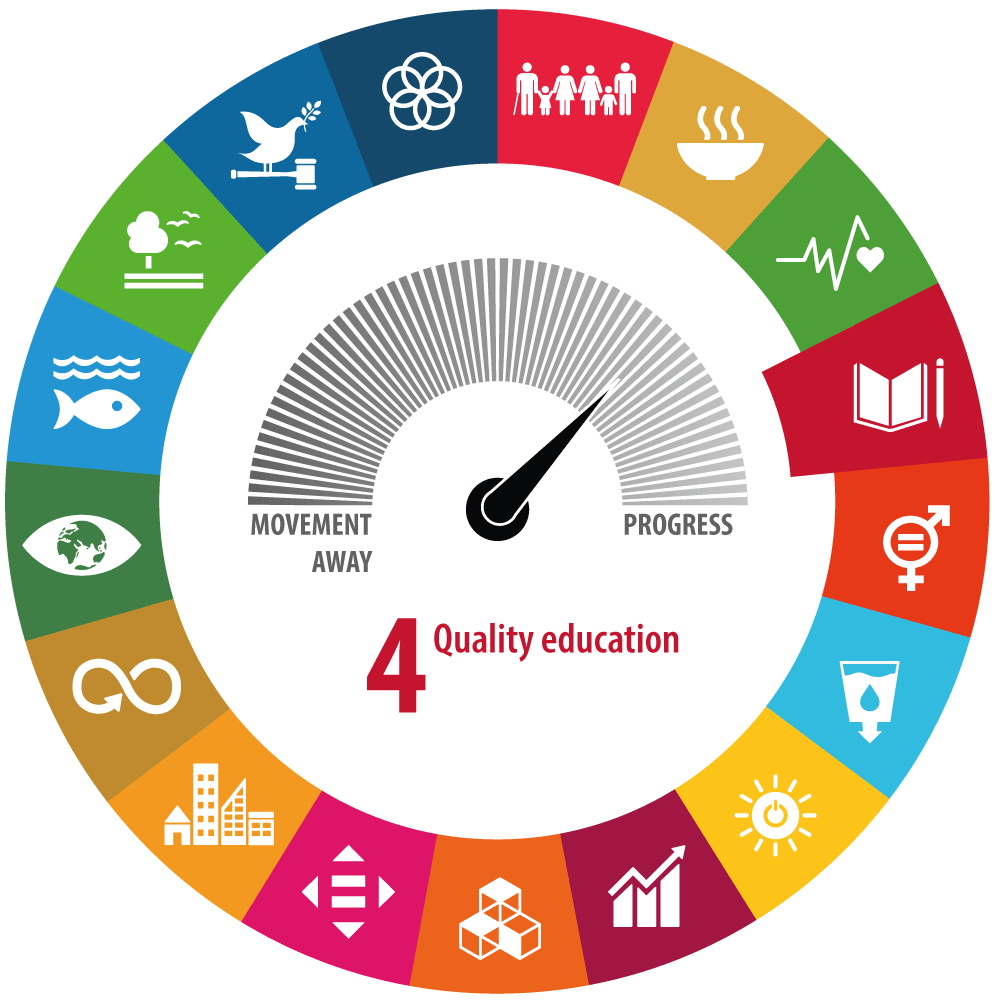Quality Education- Towards a Better Future


We now live in a world that is plagued by unsustainable ways of using natural resources, which are, in turn, getting depleted at an ever-increasing rate, worsening the condition even further. Governments across the world are holding summits but do not seem to have the political will to take necessary actions. Corruption, lack of accountability/transparency, and overall instability of global governments are on the rise. Even developed countries are observing increasing inequality, and developing countries are finding it harder to lift the poor out of food-water insecurity.
Sure, technology is changing our lives at an unprecedented rate; however, the changing pattern is highly skewed, and Pareto’s 20 is steeply shrinking to only 1.
To address the list of issues, which, by the way, is still not very exhaustive, United Nations Member States initiated a global movement to tackle these comprehensively. They came up with what we call Sustainable Development Goals, which broadly classifies issues in 17 brackets and vowed to protect the planet from all-natural/human-made social/environmental evils by 2030.

The 17 SDGs are integrated, in the sense that they recognize that action in one area will affect outcomes in others and that development must balance social, economic, and environmental sustainability.
SDGs are designed to bring the world to several life-changing ‘zeros,’ including zero poverty, hunger, AIDS, and discrimination against women and girls.
Everyone is needed to reach these ambitious targets. The creativity, know-how, technology, and financial resources from all of society is necessary to achieve the SDGs in every context. UNDP continually works to provide integrated solutions to help implement the SDGs and achieve targets in due time. In order for these solutions to work, close coordination between all stakeholders viz. Government, civil society, private sector, and citizens themselves is needed.
While many will say it is almost blasphemous to rank these SDGs, one can find interlinkages between development goals and start from the most crucial ones, which have a cascading effect on others. In a 2016 survey conducted by a world economic forum, almost 18 percent of the millennial ls recognized quality education as one of the biggest challenges.
Many think tanks strongly believe that education and then quality education is at the root of most socioeconomic evils, and driving this single wheel is one of the most powerful and proven vehicles of sustainable development. For education is not just the learning of facts but the training of the mind to think on its own. It empowers young minds to come out of biases and explore the world for their own as well as societal well-being.
The primary goal of the fourth SDG is to ensure that children of all genders complete free primary and secondary schooling by 2030. It also aims to provide equal access to affordable vocational training and to eliminate gender and wealth disparities to achieve universal access to a quality higher education.

Relevance of education in India
India presently spends about 4 percent of its GDP on education, which is far lesser than in developed countries. While we feel proud of the fact that our country has some of the finest educational institutes in the world, there is no denying that our literacy rate is still an abysmal 74 percent. Education has never been more critical for our country. We seriously need to consider education as a significant index of development if we crave to be a developed country someday. Education provides multifarious ways of improving one’s life and contributing to the country’s economy, which is so lacking in present times.
India has such a unique opportunity in terms of the rich demographic dividend that it has. Just imagine if people were educated and skilled enough to find jobs and enhance the standard of their lives, our country would be so much better. Amid fears of artificial intelligence and other technological revolutions removing the need for human labor, the importance of education has never been felt more before. The status of the primary and secondary schooling system is inferior in our country. All the education policies and budgetary funds are inconsequential if we are unable to target the educational quality enhancement of primary and secondary level. Education opens the door to endless opportunities. Even with machine learning and artificial intelligence, there is no dearth of skilled jobs. Only the repetitive jobs are being taken over by technology. With the right education and skilling, there are a plethora of opportunities in our country. Agriculture employs about 32 percent workforce while it contributes only 15 percent to GDP. This highly skewed result is due to the lack of job opportunities and education. With rightly framed policies aimed at the grass-root level, education has the potential to be a positive disruptor in present times.
Business implications

Quality Education (SDG4) is one of the goals where businesses are not directly involved as they do not have the required reach to work towards the goal significantly, but at the same time, it would benefit the private sector is seeing rapid improvements in the quality of global education. The advances, foundation, and plans of action required to deliver on the other SDGs, which are significantly crucial for companies, are hugely dependent on an educated and skilled workforce. Moreover, economic growth and new markets are reliant on an educated population. It is doubtful that the objectives for SDG4 ought to have unequivocally recognized the job of organizations in supporting and giving lifelong education and skill development.
Moreover, businesses have provided a tax base for universal, high-quality education, and delivering the necessary supporting infrastructure. They likewise have an immediate job in supporting objective 4.4, which promises to “substantially increase the number of youth and adults who have relevant skills, including technical and vocational skills, for employment, decent jobs, and entrepreneurship.” The objective focuses on the more extensive appropriation of the deep-rooted learning idea by managers and closer co-operation among organizations and schools and colleges.
Equally, target 4.7 and its pledge to help people “acquire the knowledge and skills needed to promote sustainable development” requires the broader economy requires the more extensive economy to give the right supporting condition in which understudies can find out about the risk and the value of sustainable development, gender equality, and human rights.
Embracing the SDGs can likewise assist organizations with getting progressively attractive to future representatives. One ongoing study by Global consultancy Tolerance demonstrated practically a large portion of the workforce need to work for an association that has a positive effect on the planet, while 53 percent would work more enthusiastically on the off chance that they were having any effect on other people.
At the frameworks level, organizations are progressively perceiving the need to articulate and shape the aptitudes they will require later on. It is progressively not proper for organizations to depend on national instruction frameworks to create a reasonable ability; instead, they have to enable all partners to comprehend the fate of crucial areas, the ability pipeline, and the fundamental aptitudes. This proactive commitment won’t be simple, however over our customer list we get notification from business pioneers who perceive that as of now they battle to discover female engineers, reasonable Board individuals with a ‘frameworks point of view’ or graduates with the relational aptitudes to adjust to the requests of an increasingly a multi-generational workforce.
Business opportunities

Evident indirect business openings emerge from the development of increasingly educated populaces, which will, by definition, drive commercial development and give a lift to information-based markets in particular. There are many items one cannot offer to individuals who cannot read.
Additionally, improved aptitudes bases are fundamental to driving monetary efficiency, particularly in innovative businesses that will shape the 21st century. Similarly, direct business openings will spill out of the advancement of an improved instructive framework, from books and IT to structures and green spaces.
All the more explicitly, focus on 4.4’s pledge furnishes all organizations with a chance to return to their preparation and instructive arrangements and inquire as to whether they are doing what is necessary to help and build up the workforce expected to drive practical improvement.
Closer co-operation with schools and colleges, internships, and more extensive preparing programs all allow organizations to help SDG4 and straightforwardly handle present and future aptitudes holes, while driving R&D programs in bearings that can, at last, convey business leaps forward.
Analysis and Path Ahead

We still have a substantial number of around 61 lakh children out of school. This number includes children with special needs and street children. Then within some categories like SC/ST minority groups, there is a need to focus on the girl child education. We need to have additional KGBVs (Kasturba Gandhi Balika Vidyalaya), especially in educationally backward regions.
The gross enrolment ratio has gone up in both higher and secondary education. The drop-out rate has come down. The number of schools has gone up, and according to our assessment, we are on the way to achieving 12th Plan targets. Equity issues need to be addressed. There has been an increase in the number of universities and colleges. The number of diploma level institutions have gone up. In all the centrally sponsored schemes, there has been increasing spending and consolidation, and up-gradation of central institutions and skill-based programs took place.
For tribal children, residential schools have to be built. For children of migrants, especially in urban areas, seasonal hostels have to be built. Transport arrangements have to be made. Otherwise, they may not be able to come to school. With initiatives like providing cycles to girls in Jharkhand and Chhattisgarh region, the enrolment, as well as retention of girls, has improved.
Learning enhancement and supplemental instruction have to be implemented because the children who will be coming from disadvantaged sections may not have sufficient exposure to literacy or numeracy at the time of enrolment. The focus on the involvement of local authorities and teachers training should be increased. To bridge the gender gap, the sensitization of teachers is an essential step.
Improving Quality:
The main focus should be on early education because unless the pre-primary education is effective, there will be a difficulty in achieving the learning outcomes at a later stage. A reward-punishment system should be there for teachers to retain them and to minimize absenteeism among them, especially in rural areas. A proper monitoring system should be in place to detect unethical and unprofessional practices of teachers. One of the most important things is to create and maintain a decent and modern infrastructure to create the right ambiance for students and teachers.
Convergence with other programs like NREGA (National Rural Employment Guarantee Act) and Digital India for school infrastructure, toilets, and digitization should be aimed. Lifelong learning should be made a priority and promoted to fulfil the objectives of SDGs. So make it possible, we need to focus not only on primary education but also on lifelong learning. We should develop the capability to use the information available from various sources like newspapers, magazines, mass media, and the internet. Saakshar Bharat is taking significant strides towards the goal of lifelong learning.
Education, as a concept, would need to be revisited now. Our education policies need to be aimed at primary and secondary schooling systems more than the higher education system. A class V student can hardly solve class II problems in many government schools. There are institutional lacunae in India’s educational system like these, which need to be tackled soon. Education policy needs to be tailored to meet these needs. With the advent of new technologies, we need to reskill our workforce to cater to the rising demands of the modern workplace.
References
- https://news.pg.com/press-release/pg-announces-new-environmental-sustainability-goals-focused-enabling-and-inspiring-pos
- https://www.capgemini.com/us-en/2018/03/capgeminis-commitment-to-the-united-nations-sustainable-development-goals/
- https://www.vodafone.com/content/index/about/sustainability/approach-and-reporting/our-contribution-to-the-un-sdgs.html
- https://av.sc.com/corp-en/content/docs/sustainability-aspirations-2019.pdf
- https://www.jnj.com/sustainable-development-goals
- https://www.indiatoday.in/education-today/featurephilia/story/7-immediate-changes-needed-in-the-indian-education-system-1579167-2019-08-09
- https://www.thehindu.com/opinion/open-page/recrafting-indian-education/article26481759.ece
- https://www.thehindu.com/education/set-the-priorities-right/article28419841.ece
- http://censusindia.gov.in/2011-prov-results/data_files/india/Final_PPT_2011_chapter6.pdf
- https://www.thehindu.com/opinion/open-page/liberating-the-education-system/article29418134.ece
- http://ris.org.in/pdf/SDGs_Report_Chapter_4.pdf
- https://www.businessgreen.com/bg/opinion/3072035/educating-for-sustainable-economy-the-role-of-business-in-delivering-sdg-4
- https://www.un.org/sustainabledevelopment/sustainable-development-goals/
- https://www.un.org/sustainabledevelopment/education/
- https://www2.deloitte.com/content/dam/Deloitte/global/Documents/About-Deloitte/gx-2030-purpose-report.pdf
Occasionally, some of your visitors may see an advertisement here,
as well as a Privacy & Cookies banner at the bottom of the page.
You can hide ads completely by upgrading to one of our paid plans.


